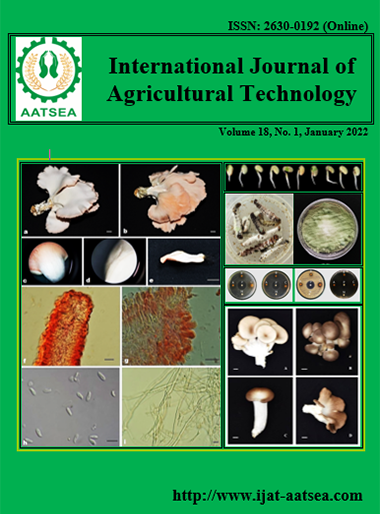Soil nitrate availability pattern as influenced by the application of vermicompost supplemented with a liquid organic fertilizer
Main Article Content
Abstract
The result of the experiment revealed that the soil available nitrate decreased at the first four weeks of the incubation and increased from weeks 5 to 7. Soil pH did not change at the first 2 weeks of the incubation, however, raised for the rest of the incubation. At the end of the incubation, the application of vermicompost at the rate of 12.5 g kg-1 supplemented with 100% LOF exhibited the greatest soil available nitrate. Also, the same treatment combination had the highest soil total nitrogen (TSN) and soil pH. This finding is significantly managed for nitrogen fertilization using vermicompost in Inceptisols
Article Details

This work is licensed under a Creative Commons Attribution-NonCommercial-NoDerivatives 4.0 International License.
References
Amusan, O. A. and Adetunji, M. T. (2013). Organic matter build-up in a tropical alfisol under a legume based integrated nutrient management system. Journal of Soil Science, 2:29-33.
Asosiasi Produsen Pupuk Indonesia (Indonesia Fertilizer Producer). (2020). Supply and Demand pupuk 2014-2020. https://www.appi.or.id/?statistic. Downloaded 18 September 2020.
AyanfeOluwa, O. E., AdeOluwa, O. O. and Aduramigba-Modupe, V. O. (2017). Nutrient release dynamics of an accelerated compost: A case study in an Alfisol and Ultisol. Eurasian Journal of Soil Science, 6:350-356. DOI: 10.18393/ejss.318795.
Balai Penelitian Tanah (2009). Analisis Kimia Tanah, Tanaman, Air dan Pupuk, Second Ed. Bogor: Balai Besar Sumberdaya Lahan Pertanian, Badan Penelitian dan Pengembangan Pertanian.
Brown, S. and Cotton, M. (2011). Changes in soil properties and carbon content following compost application: results of on-farm sampling. Compost Sci. and Utilization, 19:88-97.
Coolon, J. D., Jones, J. K., Todd, T. C., Blair, J. M. and Herman, M. A. (2013). Long-term nitrogen amendment alters the diversity and assemblage of soil bacterial communities in tallgrass prairie. PLoS ONE, 8:1-11. DOI: 10.1371/journal.pone.0067884.
Ebid, A., Ueno, H. and Ghoniem, A. (2007). Nitrogen mineralization kinetics and nutrient availability in soil amended with compost tea leaves, coffee waste and kitchen garbage. International Journal of Soil Science, 2:96-106.
Eghball, E. B., Wienhold, B. J., Gilley, J. E. and Eigenberg, R. A. (2002). Mineralization of manure nutrients. The Journal of Soil and Water Conservation, 57:470-473.
He, Z. L., Alva, A. K., Calvert, D. V. and Banks, D. J. (1999). Ammonium volatilization from different sources and effects of temperature and soil pH. Soil Science, 164:750-758. DOI: 10.1097/00010694-199910000-00006.
Joergensen, J. G., Mader, P. and Fliebach, A. (2010). Long-term effects of organic farming on fungal and bacterial residues in relation to microbial energy metabolism. Biol Fertil Soils, 46:303-307.
Katterer, T., Reichstein, M., Andrén, O. and Lomander, A. (1998). Temperature dependence of organic matter decomposition: a critical review using literature data analyzed with different models. Biology and Fertility of Soils, 27:258-262. DOI: 10.1007/s003740050430.
Kirschbaum, M. (2006). The temperature dependence of organic-matter decomposition—still a topic of debate. Soil Biology and Biochemistry, 38:2510-2518. DOI: 10.1016/j.soilbio.2006.01.030.
Kirschbaum, M. U. F. (2010). The temperature dependence of organic matter decomposition: seasonal temperature variations turn a sharp short-term temperature response into a more moderate annually averaged response. Global Change Biology, 16:2117-2129. DOI: 10.1111/j.1365-2486.2009.02093.x.
Muktamar, Z., Hasibuan, S. Y. K., Suryati, D. and Setypwati, N. (2015). Column Study of nitrate downward movement and selected soil chemical properties’ changes in mine spoiled soil as influenced by liquid organic fertilizer. Journal of Agricultural Technology, 11:2017-2027.
Muktamar, Z., Sudjatmiko, S., Fahrurrozi, F., Setyowati, N. and Chozin, M. (2017a). Soil chemical improvement under application of liquid organic fertilizer in closed agriculture system. International Journal of Agricultural Technology, 13:1715-1727.
Muktamar, Z., Sudjatmiko, S., Chozin, M. and Setyowati, N. (2017b). Sweet corn performance and its major nutrient uptake following application of vermicompost supplemented with liquid organic fertilizer,” International Journal on Advanced Science, Engineering and Information Technology, 7:602-607.
Muktamar, Z., Adiprasetyo, T., Yulia, Suprapto, Sari, L., Fahrurrozi, F. and Setyowati, N. (2018). Residual effect of vermicompost on sweet corn growth and selected chemical properties of soils from different organic farming practices. International Journal of Agricultural Technology, 14:1471-1482, 2018.
Muktamar, Z., Lifia, L. and Adiprasetyo. (2020). Phosphorus availability as affected by the application of organic amendments in Ultisols,”. Sains Tanah - Journal of Soil Science and Agroclimatology, 17:16-22. DOI: 10.20961/stjssa.v17i1.41284.
Murugan, A. V. and Swarnam, T. P. (2013). Nitrogen release pattern from organic manures applied to an acid soil. The Journal of Agricultural Science, 5:174-184. DOI: 10.5539/jas.v5n6p174.
Raphael K. and Velmourougane, K. (2011). Chemical and microbiological changes during vermicomposting of coffee pulp using exotic (Eudrilus eugeniae) and native earthworm (Perionyx ceylanesis) species. Biodegradation, 22:497-507. DOI: 10.1007/s10532-010-9422-4.
Romero, C. M., Engel, R., Chen, C. and Wallander, R. (2015). Microbial immobilization of nitrogen-15 labeled ammonium and nitrate in an agricultural soil. Soil Science Society of America Journal, 79:595–602, DOI: 10.2136/sssaj2014.08.0332.
Savci, S. (2012). An Agricultural Pollutant: Chemical Fertilizer. International Journal of Environmental Science and Development, 3:77-80. DOI: 10.7763/IJESD.2012.V3.191.
Spark, D. L. (2003). Environmental Soil Chemistry. Second Ed. Academic Press. New York. 352 p.
Seufert, V., Ramankutty, N. and Foley, J. A. (2012). Comparing the yields of organic and conventional agriculture. Nature, 486:229-232. DOI: 10.1038/nature11069.
Wallenstein, M. D., McNulty, S., Fernandez, I. J., Boggs, J. and Schlesinger, W. H. (2006). Nitrogen fertilization decreases forest soil fungal and bacterial biomass in three long-term experiments. Forest Ecology and Management, 222:459-468.
Wijanarko, A. and Purwanto, B. H. (2017). Effect of land use and organic matter on nitrogen and carbon labile fractions in a Typic Hapludult. Journal of Degraded and Mining Lands Management, 4:837-843. DOI: 10.15243/jdmlm.2017.043.837.
Wulandari, J., Muktamar, Z. and Widodo. (2017). The change in selected soil chemical properties of Ultisols and the growth of sweet corn (Zea mays, Saccharata Sturt L.) after application of organic and nitrogen fertilizer. in Mendorong Kedaulatan Pangan melalui Pemanfaatan Sumberdaya Unggul Lokal, Balunijuk, 2017, pp. 400-407 (In Indonesian).


